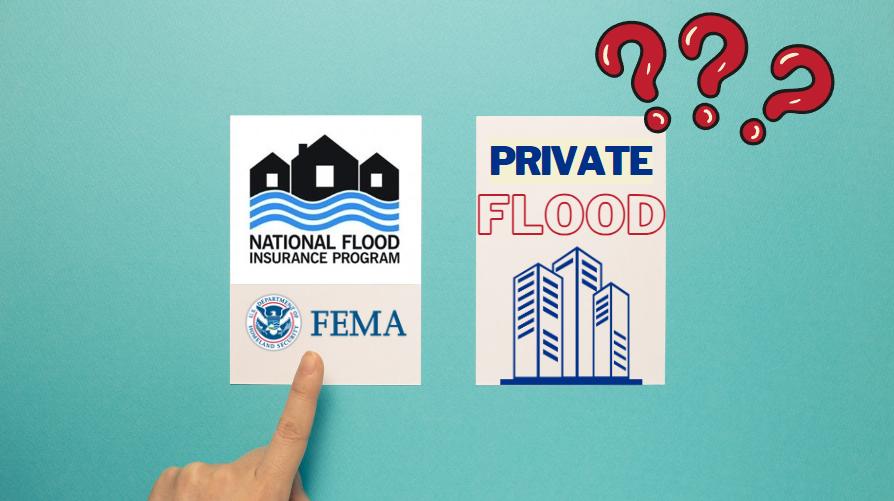The Ultimate Guide to Flood Insurance: Protecting Your Home in 2024
Welcome to the comprehensive guide to flood insurance, where we demystify flood coverage’s complexities to help homeowners and investors protect their properties effectively. Whether you’re considering purchasing flood insurance for the first time or seeking to optimize your existing coverage, understanding the nuances of flood zones, insurance policies, and coverage options is crucial.
In this guide, we will cover the following topics:
- Introduction
- Understanding Flood Zones
- Flood Insurance Options
- Coverage Essentials
- Factors Influencing Flood Premiums
- Making Informed Decisions
- Conclusion
- Frequently Asked Questions (FAQs)
Introduction: What is Flood Insurance?
You would want to get flood insurance when protecting your property from flood damage and loss.
Flood Insurance is a separate flood insurance policy dedicated to providing coverage for properties affected by flooding. It’s important to keep in mind that standard homeowners insurance policies (or simply home insurance) don’t have comprehensive flood coverage.
This is why property owners need flood insurance to cover the losses due to floods. To understand flood insurance, we first need to understand flood zones and how they impact flood insurance purchases.
Understanding Flood Zones: High-Risk vs. Low-Risk Areas
Flood zones categorize geographic regions based on their susceptibility to flooding, influencing insurance requirements and expectations. Generally, flood zones are categorized into two main descriptions in FEMA’s flood map: high-risk and low-risk flood zones.
Here’s what you need to know:
High-Risk Flood Zones
Properties located in high-risk flood zones, such as Special Flood Hazard Areas (SFHAs) designated by FEMA’s Flood Insurance Rate Maps (FIRMs), face elevated flood risks. These areas are determined as high-risk areas using the flood studies made by the floodplain management. Insurance through the National Flood Insurance Program (NFIP) is often mandatory for mortgages in these areas to protect against potential flood damage.
These high-risk flood zones generally start with the letter A or V. So if your property sits in a flood zone A, AE, V, or VE, you are mapped in the SFHA and will be required to carry flood insurance.
Low-Risk Flood Zones:
Low-risk flood zones typically include areas outside SFHAs, where flood insurance may not be required for mortgage purposes but is still recommended. Despite lower perceived risks, climate changes and local developments can alter flood dynamics, making insurance coverage a wise precaution. To give an example, the Federal Emergency Management Agency (FEMA) reports that more than 20% of flood insurance claims come from low-risk flood zones like Flood Zone X.
If you want an in-depth discussion on flood zones and how they differ, you can CLICK HERE to go to our dedicated flood zone page.
Flood Insurance Options: NFIP vs. Private Insurance
Now that we have covered flood zone designation and flood insurance, you may start to get think of where you can buy a policy to protect you from flooding. When you buy flood insurance, you can do so through federal flood insurance or private insurance companies. These options are better known as NFIP flood and Private Flood.
Understanding the differences between NFIP and private flood insurance policies helps in choosing the right coverage tailored to your needs:
National Flood Insurance Program (NFIP)
Also known as federal flood insurance, this option is administered by FEMA. The NFIP offers standardized flood insurance policies with consistent pricing across participating insurers. Key features include:
- Mandatory Coverage:
This simply means that if you have a home that is sitting on a Flood Zone A or Flood Zone AE, both FEMA and your mortgage will require you to purchase flood insurance. - Standardized Premiums:
When buying a federal flood policy, regardless of the insurance company you’re getting it from, the cost of flood insurance should be the same when looking at an NFIP policy. - Coverage Limits:
One thing to keep in mind when buying NFIP insurance is the amount of coverage they can offer. This is because residential flood insurance through the NFIP maxes out at $250,000 for building coverage and $100,000 for contents. If you’re buying a commercial flood insurance policy, this coverage limit with federal flood will max out at $500,000 for both building and contents.
Private Flood Insurance
When it comes to your other option, you can go through private companies that provide flood insurance. A key difference between a private flood insurance company compared to the NFIP is that these policies provide customizable coverage options that may include higher limits and additional benefits not available under the NFIP. Let’s talk more about these differences:
- Flexibility
Private flood tailors flood policies to meet specific property needs and flood risk profiles. One of the key examples of this can be seen with the coverage amount you can get from them. Private insurance companies offer flood coverage that goes higher than $250,000 for buildings and $100,000 for contents. This means that if you have a home that needs $350,000 building coverage, private flood can provide this amount.Additionally, insurance providers in the private flood market can also include “excess coverage”. This excess coverage can be in the form of Additional Living Expenses or Loss of Use. Keep in mind that federal flood insurance covers only buildings and contents, so getting excess coverage can be a great help in bouncing back from a flood event.
- Competitive Pricing
Premiums may vary based on individual risk assessments, offering potential cost savings or enhanced coverage. To add to this, when you are shopping with private flood insurance, you can get more options as each insurance company has unique offers, benefits, and premium calculations. This in turn gives you the power to decide where you want to get your flood insurance in the private market.
Coverage Essentials: What Flood Insurance Protects
In the previous sections, we have been discussing flood insurance coverage amounts offered by both NFIP and private flood, but what do these coverages really mean? In this section, we want to discuss the difference in the coverages found in a flood policy and where the coverage will be used if you experience damage to your home because of flooding.
Flood insurance policies typically cover three primary areas to mitigate financial losses from flood damage:
1. Building Coverage
As the name dictates, building coverage protects the physical structure of your home, including foundation, walls, and built-in appliances. This coverage may also be known as coverage on structures or dwelling coverage. Additionally, building coverage in flood insurance will also cover the costs of repairing, renovating, or rebuilding the structure of your insured property, labor, and debris cleanup.
One thing to keep in mind when buying flood insurance is what we call the 80% Rule. You can watch our video below to learn more about this rule.
2. Contents Coverage
On the other hand, contents or personal property coverage safeguards personal belongings within the home, such as furniture, electronics, and clothing. This coverage includes portable appliances like microwave ovens. Depending on your insurance provider, contents may also cover artwork, photographs, memorabilia, rare books, and jewelry.
3. Additional Living Expenses (ALE)
This coverage can only be found in private flood insurance as NFIP does not have this coverage. So what is it? ALE or additional living expenses coverage provides financial assistance for temporary living arrangements if your home becomes uninhabitable due to flood damage.
Private flood insurance companies can offer up to $25,000 for this excess flood coverage which can be of great help when displaced due to flooding. This means that you won’t have to worry about the cost of lodging, motel costs, and even additional food costs giving you that peace of mind and financial security as you wait to get back to your home.
Understanding these coverage areas ensures comprehensive protection against the financial impacts of flood-related losses.
Factors Influencing Flood Premiums
Flood zones will no longer determine flood insurance prices, so you might be asking. One thing to know about flood insurance in 2024 is that several factors affect flood insurance premiums, including:
- Property Location: Proximity to water bodies and flood zones. This means that both NFIP and private insurers will look at how close or far the property is from any body of water like rivers, creeks, lakes, or even the coasts to determine the pricing on a policy.
- Building Elevation: Height above Base Flood Elevation (BFE). Base flood elevation is the level that FEMA or the National Flood Insurance Program feels that flooding could come to on a regular basis. This means that insurers will look at the height of your property’s lowest floor from the BFE to determine both pricing and assess the risk of flooding on a property.
- Flood Risk Score: Assessment of flood probability based on historical data and geographic factors. This is one of the key factors that can tip the scale of how much flood insurance will cost. A property’s flood risk score is a good indicator of how much flood risk the property is facing hence can help in determining how much premium the policy for that property will get.
- Coverage Limits: Amount of insurance purchased for building and contents. For private flood, some insurers may have excess coverage as an option which means that opting into getting that extra flood coverage can increase your premiums. Keep in mind that when it comes to coverage, the 80% rule will still apply.
- Deductibles: This is known as the out-of-pocket expenses before insurance coverage begins. Although deductibles don’t have a big impact on flood insurance prices compared to other factors, they can still affect how much your flood policy will turn out. A deductible is the money that you’ll pay out of pocket once you file a flood claim.
Evaluating these factors helps homeowners and investors anticipate insurance costs and select appropriate coverage levels.
Making Informed Decisions: Purchasing Flood Insurance
When purchasing flood insurance, consider these essential steps to ensure adequate coverage and protection:
Consultation
Discuss options with an insurance agent familiar with flood insurance policies and regulations. Reaching out to an agent who has experience working on flood insurance can provide the best guidance as they can provide everything you need to know about flood insurance, what options to consider, how to best manage your coverage, and get you the best pricing in the market.
We highly encourage homeowners and business owners to consult with an insurance agent from start to finish. This means that you’d want to connect with someone who can assist and guide you from flood insurance application to the time you’re filing a claim.
Policy Comparison
Compare NFIP and private insurance offerings to find the best coverage and pricing. When you buy a flood policy, it doesn’t have to be a one-way road. We encourage you to shop for all available options for your property. This means that you want to get a quote from NFIP and a variation of private flood quotes through different insurers. By doing this, you can answer “How much does flood insurance cost?” and learn how pricing and coverages differ from one option to another.
Review Requirements
Understand lender requirements and community floodplain management regulations. Earlier in this guide, we provided information on why property owners may be required to purchase flood insurance. By learning and understanding regulations and mandatory requirements on flood insurance, you can ensure that when you purchase a policy, you’re getting the best deal for your finances. Doing this helps property owners meet lender requirements and federal regulations without breaking the bank.
Additionally, securing certain documents like an Elevation Certificate (EC) when you’re shopping for flood insurance can help in providing a more accurate risk representation and expectations on how your policy will turn out. If you want to learn more, CLICK HERE to go to our dedicated page on Elevation Certificates.
Long-Term Planning
To maximize your coverage, we encourage your flood insurance to anticipate future changes in flood risk and insurance needs based on evolving environmental and regulatory landscapes. This means that you want to ensure that flood mitigation is in place to lessen the impact of flooding and develop a financial plan for when your policy renews. Doing this can help you get affordable flood insurance for the long term. Having a long-term plan with your flood protection and insurance can help in securing financial stability.
Conclusion: Securing Your Future Against Flood Risks
Flood insurance is a critical safeguard against the financial devastation of flood damage, offering peace of mind and financial security for homeowners and investors alike. By understanding flood zones, insurance policies, coverage options, and premium factors, you can make informed decisions to protect your most valuable assets.
For more information on navigating flood insurance or to explore personalized coverage options, contact your insurance agent or visit our website. Protect your home and investments today to ensure a resilient future amidst the uncertainties of natural disasters.
FAQs on Flood Insurance
Question: Should I get flood insurance even if I’m not in a high-risk flood zone?
Although flood insurance is not required for properties located outside the special flood hazard areas (SFHA) like Flood Zone X, we highly encourage getting a flood policy to protect your property. For one, FEMA has recorded that at least 25% of flood claims come from properties outside of high-risk flood zones and more importantly, this added additional protection for your finances and property as it has insurance coverage in case of flooding.
Question: Are Elevation Certificates Required?
With the introduction of FEMA’s Risk Rating 2.0, elevation certificates are no longer mandatory for obtaining flood insurance through the National Flood Insurance Program (NFIP). This change can potentially save homeowners money and hassle. However, accurate elevation data can still significantly impact insurance rates.
Question: How long is a flood insurance price good for?
Flood insurance pricing is good for 12 months. This means that your quote and policy’s premium will remain the same for a whole year.
Question: Why does flood insurance cost differ in each location?
When it comes to federal flood insurance, these NFIP policies should be all the same regardless of your location or what company you’re getting the federal flood policy from. However, on the private flood insurance side, each company uses different rating models and structures as each company has a different type of appetite for risk. This could mean that certain could be considered “riskier” areas hence the difference in flood insurance costs.
Question: My homeowners’ insurance company offered me flood coverage, do I still need flood insurance?
Yes. Although some insurance companies for home policies may provide flood coverage, we still encourage buying a separate flood insurance policy so that you can get coverage on top of what you’re offered. This way, you can ensure that you have comprehensive financial coverage for when flooding happens.
Question: I am renting a house, do I still need flood insurance?
Renters insurance policies are also applicable for flood. Although you may not own a home, flood insurance coverage is set up to allow renters to get contents coverage ensuring that you will be able to financially bounce back when the property gets flooded for your personal items.
Question: Can improvements to my property lower my flood insurance cost?
Flood insurance can be expensive and ensuring that property improvements like elevating your home, sandbagging, and installing flood vents can help in reducing flood premiums. This is especially true if you and your community make an effort to improve flood mitigation as this is rewarded by the NFIP for participating communities through their Community Rating System (CRS).

Information contained on this page is provided by an independent third-party content provider. This website make no warranties or representations in connection therewith. If you are affiliated with this page and would like it removed please contact editor @producerpress.com












